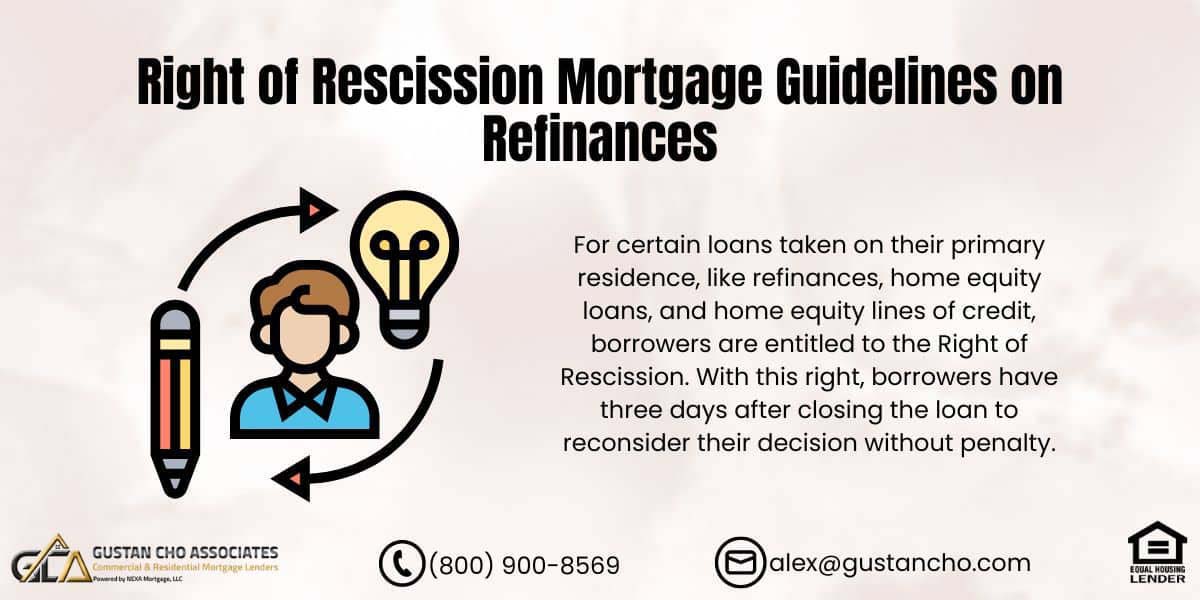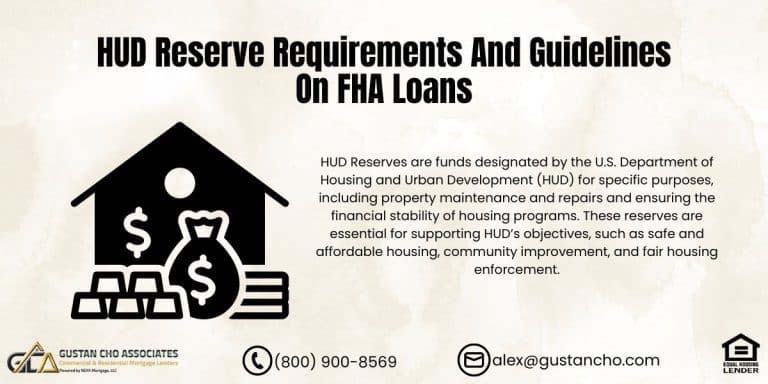This guide covers the right of rescission mortgage guidelines on refinances. As we have seen interest rates drop over the past month and a half, we have seen a rise in refinance mortgage transactions. Thousands of Americans are taking advantage of the temporary rate decrease the FEDERAL RESERVE has put in place.
It is no secret that President Trump has been tough on Chair of the Board of Governors of the Federal Reserve, JEROME H. POWELL. Adding pressure on the Federal Reserve to cut interest rates to keep us in line with the global markets. In the blog, we will explain the refinance timeline and detail the right to rescind and how it pertains to mortgage lending. In this article, we will cover and discuss the right of rescission mortgage guidelines on refinances.
What is the Right of Rescission in Mortgage Loans
Rescission in mortgage loans refers to the borrower’s legal right to cancel or revoke the loan agreement under specific conditions. This right is particularly relevant under the provisions of the Truth in Lending Act (TILA) in the United States. Here’s a closer look at how rescission operates within mortgage loans:
Legal Basis for The Right of Rescission
Rescission is a protection mechanism provided by TILA designed to give consumers a “cooling-off” period during which they can reconsider their mortgage agreement without penalty. The right to rescind helps ensure borrowers fully know their rights and commitments with a new mortgage, especially in refinancing and home equity situations.
Applicability on the Right of Rescission
Rescission primarily applies in the following scenarios:
- Refinancing Transactions: Borrowers refinancing their existing mortgage with a different lender have the right to rescind.
- Home Equity Loans: When a borrower takes out a home equity loan.
- Lines of Credit: Opening a home equity line of credit on a primary residence.
The right of rescission does not apply to the original mortgage used to purchase the home. It typically does not apply when refinancing with the same lender without borrowing additional funds.
Refinancing? You Have 3 Days to Cancel—No Penalty, No Pressure
Know your rights before it’s too late—get your free refinance rescission guide today!
The Right of Rescission in the Mortgage Process
Three-Day Period: The borrower has three business days after the last of the following events to rescind the loan: the signing of the loan agreement, receiving the Truth in Lending disclosures (clearly outlining the loan terms, annual percentage rate, finance charges, etc.), and receipt of the notice of right to rescind.
Notice: To rescind, the borrower must notify the lender in writing within three days. The notice doesn’t have to be formatted in any specific way. However, it must indicate the borrower’s intention to rescind the contract.
Return of Funds: Any money or property exchanged must be returned upon rescission. The lender must return any fees or payments collected related to the loan agreement within 20 days after receiving the rescission notice. Loan Nullification: The loan is considered null and void from inception, with no penalty to the borrower.
Importance of Rescission
The right of rescission is crucial for consumer protection. It safeguards borrowers against entering into financial agreements without full understanding or under pressure. This period allows them to assess the implications of the loan and ensure it is in their best interest without immediate risk or loss.
Understanding the right of rescission is important for any borrower considering a mortgage refinance or a home equity line of credit, as it offers a critical opportunity to back out of a potentially burdensome financial commitment legally and safely.
Refinancing a Primary Home
Gustan Cho Associates are experts in mortgage refinancing. Below we will go over our refinance process step-by-step. We do our best to make this process as easy as possible on our clients. We have a friendly support staff who will keep you up to date on your refinance process.
Steps in Refinancing an Owner-Occupant Primary Home
In this paragraph, we will be talking about the steps in refinancing an owner-occupant primary residence.
- Step 1: Contact Gustan Cho Associates at (800) 900-8569 or email us at gcho@gustancho.com.
- Step 2: Have a one-on-one consultation about your refinance goals. Every refinance is different. Some clients would like to take cash out, someone to lower their term and pay the loan off sooner, some clients are interested in an FHA STREAMLINE or VA IRRRL transaction. We offer a wide range of refinance opportunities.
- Step 3: After your one-on-one consultation, you will be emailed an application link and documents required to start the refinance process. Those documents include a current mortgage statement, homeowners’ insurance declarations page (or contact information for your agent), the last two years of W-2’s (some clients will require two years of tax returns), last 30 days’ worth of pay stubs, and a government-issued photo ID. In some cases, you will need to provide your last two bank statements (all pages).
- Step 4: Complete the online application and send in the documentation above.
- Step 5: Once we receive your signed loan disclosures, we will then order the appraisal and title work. Then send your file to the underwriter. During the underwriting process, the appraiser will come to your home and complete the inspection. At this time the loan PROCESSOR will order all required verifications
- Step 6: Underwriter issues CONDITIONAL APPROVAL. This will include what documents are needed from you to close your loan. You will be sent a list of items to send in.
- Step 7: We now have all documents from you, appraisal, and title work, we will send the file back to the underwriter and issue the CLEAR TO CLOSE.
- Step 8: Close on your refinance. In most states, a mobile notary will come to your home (or meet you somewhere), in other states you will go to a title company. You will sign the loan documents and now start the three-business day clock to fund. This waiting period is called the “right to rescission” period.
- Step 9: After the three business days “right to rescission” period, your loan will fund, and the transaction is complete
CONGRATULATIONS! You now understand the steps of the mortgage process. In the next section, we will cover What is the right to rescind?
Refinanced Your Home? You Can Still Cancel Within 3 Days
You have a legal right to change your mind—no penalty, no obligation.
What is The Right of Rescission on Refinances
Now we will talk about the right to rescind after signing your closing documents. Keep in mind there is no right to rescind for a purchase transaction, this only pertains to refinance transactions. The right to rescind gives the consumer the right to cancel the refinance transaction before the loan funds.
Right of Rescission Timeframe
The 3-day clock starts after ALL of the following events have occurred: You sign all required closing documents including Promissory Note. You received your Closing Disclosure. You received two notices explaining your right to rescind. The three-day clock starts the first business day after these items are received.
Typically, these items are all received during the signing of the refinance documents. Business days in the mortgage industry are considered all days except Sundays and federal holidays. Saturdays do count as a business day. If the third day lands on a Saturday, your loan will not fun until the following Monday.
Right of Rescission Mortgage Guidelines Deadline Date
However, you must rescind before midnight on that Saturday to cancel the transaction. If you want to rescind, you must use the form provided in the closing documents. Make sure it is mailed or delivered before the third business day. We recommend that you keep a copy of delivered letter and delivery time frame. For more information, please visit the CFPB WEBSITE.
These laws were put in place by the Consumer Financial Protection Bureau to ensure borrowers are making an informed decision. Once again, the right to rescission time frame only pertains to refinance transactions, home equity loans, or home equity lines of credit on a primary residence. The three-day clock does not apply to a second home or an investment property.
Qualifying For a Mortgage Refinance With a Lender With No Overlays
There are times where clients are not aware of how much benefit a refinance can have on their financial future. We encourage you to contact Gustan Cho Associates today. Our expert loan officers will walk you through the ins and outs of refinancing. They will also provide you multiple refinance options.
Depending on your current rate and equity position, we usually save our clients more money than they expected. Reach out to the Gustan Cho Associates today. Call Gustan Cho, (800) 900-8569 ! We look forward to hearing from you.
FAQ About the Right of Rescission Mortgage Guidelines on Refinances
- 1. What is the Right of Rescission in mortgage refinancing? For certain loans taken on their primary residence, like refinances, home equity loans, and home equity lines of credit, borrowers are entitled to the Right of Rescission. With this right, borrowers have three days after closing the loan to reconsider their decision without penalty.
- However, it should be noted that this right does not apply to original purchase mortgages or refinances where the same lender provides no additional funds.
- 2. How does the Right of Rescission work? After signing the refinancing documents, borrowers have until midnight of the third business day to rescind or cancel the agreement. This period allows the borrower to review the agreement and ensure it is in their best interest without facing financial penalties.
- 3. What triggers the start of the Right of Rescission period? The Right of Rescission period begins once the borrower has signed the loan documents, received the Truth in Lending disclosures, and received a notice explicitly stating their right to rescind. This period includes Saturdays but excludes Sundays and federal holidays.
- 4. What steps should a borrower take to rescind a loan? To exercise the Right of Rescinding, the borrower must notify the lender in writing within three days. The notice doesn’t need a specific format but must clearly indicate the borrower’s intention to rescind the loan.
- 5. What happens after a loan is rescinded? Once a loan is rescinded, the lender must refund any fees or payments the borrower makes related to the credit transaction within 20 days. The loan agreement is invalid, meaning it’s treated as if it never existed.
- 6. Are there loans where the Right of Rescission does not apply? Yes, the Right of Rescission does not apply to refinancing with the same lender unless additional funds are borrowed. It does not apply to loans for purchasing a home, secondary homes, or investment properties.
- 7. What should borrowers expect during the rescission period? No loan funds can be disbursed to the borrower during the rescission period. This delay ensures that the funds still need to be transferred if the borrower decides to rescind.
- 8. How can borrowers prepare for the Right of Rescission? Borrowers should review all documents and fully understand the terms during this period. It is also advisable to keep copies of any communication sent to the lender regarding rescission.
- 9. What if the Right of Rescission period ends on a non-business day? Suppose the third day of the Right of Rescission period falls on a Sunday or a federal holiday. In that case, the period is extended to the next business day.
- 10. Where can borrowers find more information? For more details, borrowers can visit the Consumer Financial Protection Bureau (CFPB) website or consult their lender to get precise information about their specific scenario.
These guidelines are essential for borrowers considering refinancing options. They provide a safety net for reassessing financial decisions related to mortgage adjustments.
Just Closed on a Refinance? You Still Have Time to Walk Away
Get our free step-by-step rescission guide now









